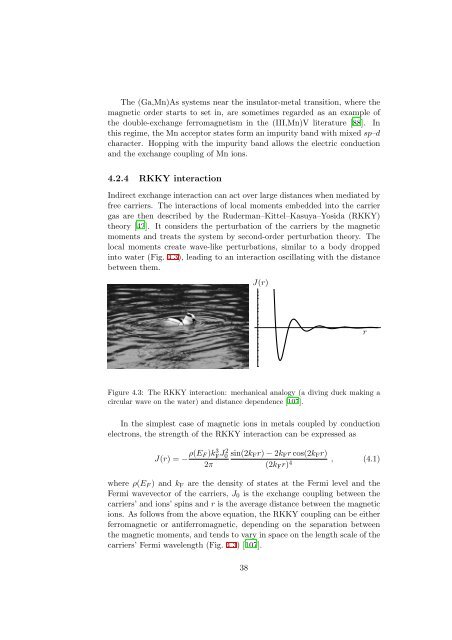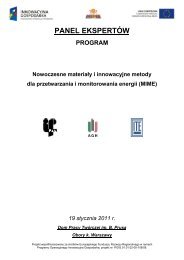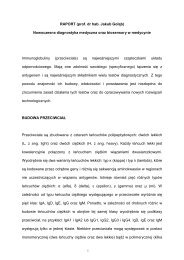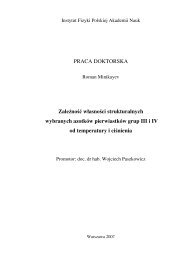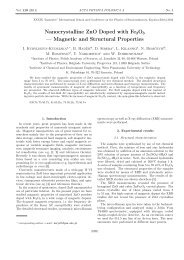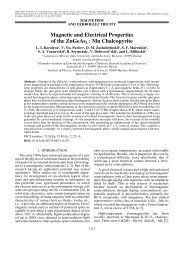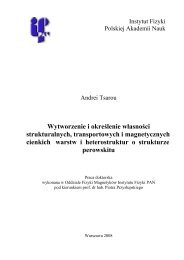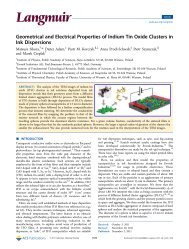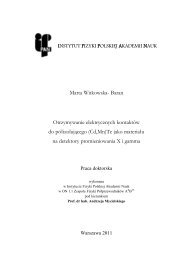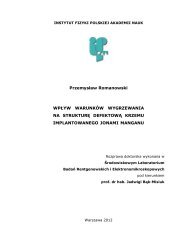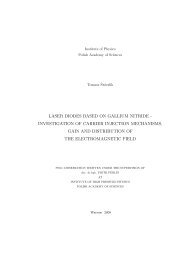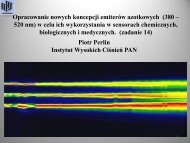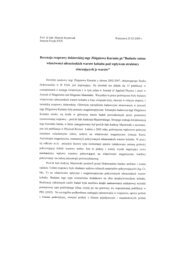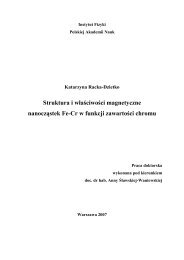Spin waves and the anomalous Hall effect in ferromagnetic (Ga,Mn)As
Spin waves and the anomalous Hall effect in ferromagnetic (Ga,Mn)As
Spin waves and the anomalous Hall effect in ferromagnetic (Ga,Mn)As
You also want an ePaper? Increase the reach of your titles
YUMPU automatically turns print PDFs into web optimized ePapers that Google loves.
The (<strong>Ga</strong>,<strong>Mn</strong>)<strong>As</strong> systems near <strong>the</strong> <strong>in</strong>sulator-metal transition, where <strong>the</strong>magnetic order starts to set <strong>in</strong>, are sometimes regarded as an example of<strong>the</strong> double-exchange ferromagnetism <strong>in</strong> <strong>the</strong> (III,<strong>Mn</strong>)V literature [88]. Inthis regime, <strong>the</strong> <strong>Mn</strong> acceptor states form an impurity b<strong>and</strong> with mixed sp–dcharacter. Hopp<strong>in</strong>g with <strong>the</strong> impurity b<strong>and</strong> allows <strong>the</strong> electric conduction<strong>and</strong> <strong>the</strong> exchange coupl<strong>in</strong>g of <strong>Mn</strong> ions.4.2.4 RKKY <strong>in</strong>teractionIndirect exchange <strong>in</strong>teraction can act over large distances when mediated byfree carriers. The <strong>in</strong>teractions of local moments embedded <strong>in</strong>to <strong>the</strong> carriergas are <strong>the</strong>n described by <strong>the</strong> Ruderman–Kittel–Kasuya–Yosida (RKKY)<strong>the</strong>ory [42]. It considers <strong>the</strong> perturbation of <strong>the</strong> carriers by <strong>the</strong> magneticmoments <strong>and</strong> treats <strong>the</strong> system by second-order perturbation <strong>the</strong>ory. Thelocal moments create wave-like perturbations, similar to a body dropped<strong>in</strong>to water (Fig. 4.3), lead<strong>in</strong>g to an <strong>in</strong>teraction oscillat<strong>in</strong>g with <strong>the</strong> distancebetween <strong>the</strong>m.J(r)rFigure 4.3: The RKKY <strong>in</strong>teraction: mechanical analogy (a div<strong>in</strong>g duck mak<strong>in</strong>g acircular wave on <strong>the</strong> water) <strong>and</strong> distance dependence [107].In <strong>the</strong> simplest case of magnetic ions <strong>in</strong> metals coupled by conductionelectrons, <strong>the</strong> strength of <strong>the</strong> RKKY <strong>in</strong>teraction can be expressed asJ(r) = − ρ(E F)k 3 F J2 02πs<strong>in</strong>(2k F r)−2k F rcos(2k F r)(2k F r) 4 , (4.1)where ρ(E F ) <strong>and</strong> k F are <strong>the</strong> density of states at <strong>the</strong> Fermi level <strong>and</strong> <strong>the</strong>Fermi wavevector of <strong>the</strong> carriers, J 0 is <strong>the</strong> exchange coupl<strong>in</strong>g between <strong>the</strong>carriers’ <strong>and</strong> ions’ sp<strong>in</strong>s <strong>and</strong> r is <strong>the</strong> average distance between <strong>the</strong> magneticions. <strong>As</strong> follows from <strong>the</strong> above equation, <strong>the</strong> RKKY coupl<strong>in</strong>g can be ei<strong>the</strong>r<strong>ferromagnetic</strong> or anti<strong>ferromagnetic</strong>, depend<strong>in</strong>g on <strong>the</strong> separation between<strong>the</strong> magnetic moments, <strong>and</strong> tends to vary <strong>in</strong> space on <strong>the</strong> length scale of <strong>the</strong>carriers’ Fermi wavelength (Fig. 4.3) [107].38


